I looked at the model of the Swedish barque and she appears to have finer lines than the Jeanie Johnson or Queen of the West. A lot of speculation here, but I would guess that the Barbara would have more resembled the latter two, which were burdensome packets. The Swedish barque is more of a clipper type, designed to carry less but with greater speed.
You are using an out of date browser. It may not display this or other websites correctly.
You should upgrade or use an alternative browser.
You should upgrade or use an alternative browser.
Yes. I think the Barbara may have been designed originally as a cargo ship meant to carry things like "flour, Indian meal, wheat, butter, hams, ashes, bacon, staves" (her cargo in 1847 when she returned from Montreal). Carrying emigrants to the States was a money-making opportunity that many ship owners jumped at--some reputable, some not so much. You've probably heard of the coffin ships from Ireland during the Great Famine. And so, yes, she probably was not as sleek as the Swedish barque.
While rummaging around for information on the Barbara, I ran across a book written in 1851 by a priest which was meant as a sort-of travel guide for a prospective emigrant (https://www.google.com/books/edition/The_Irish_Emigrant_s_Guide_for_the_Unite/SnRNAAAAYAAJ?hl=en). The following are a couple of excepts from that book relating to ships. Note the warning not to be deceived by a fresh coat of paint!
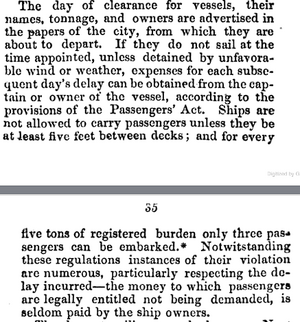
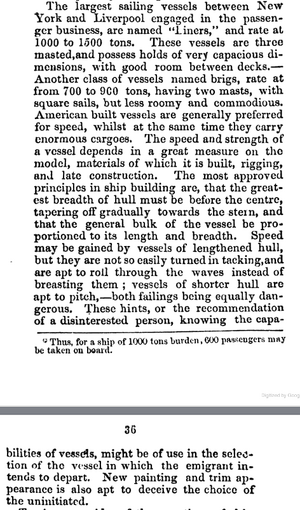


This is a final update on researching the Barbara. I have not been able to find her plans. However, if I try to build her in the future, I’ll probably use plans from a packet ship of the time and modify them to fit the description provided in the Lloyd’s survey above. I was able to find quite a lot about the Barbara’s history and am in the process of writing an article which I hope will be published in an historical journal in Limerick.
Here are a few notes and sources in case anyone is interested.
I was able to find the builder of the Barbara (Alexander Lyle of Halifax in 1846), her owner (Robet Dudley Persse, Esq. of Galway), and her Captain (James MacKay of Arbroath, Scotland). She made 4 voyages with emigrants to the United States between 1846 and 1850 as well as numerous others, primarily to Liverpool and St. Petersburg in Russia—trading primarily in goods such as flour, Indian meal, wheat, butter, hams, ashes, bacon, staves and guano.
Her owner, R. D. Persse, died in 1850 and all records for the Barbara disappear after that. It is unlikely she sank (or there would have been newspaper articles) or sold at public auction (no advertisements of a sale). She probably was sold privately, given a new name and a new Captain.
These are good sources for this kind of research:
Lloyd’s Register of Ships: https://archive.org/details/@lrfhec?&sort=-publicdate&page=2
Lloyd’s Documents related to ship plans and surveys: https://hec.lrfoundation.org.uk/archive-library/ships
British papers: https://www.britishnewspaperarchive.co.uk/
papers: https://www.britishnewspaperarchive.co.uk/
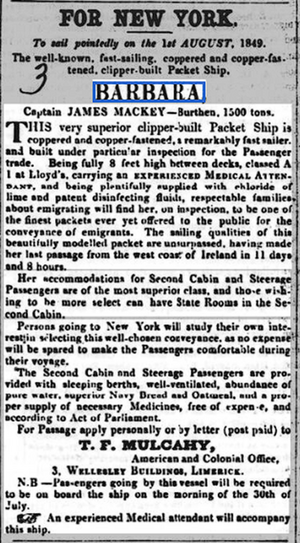
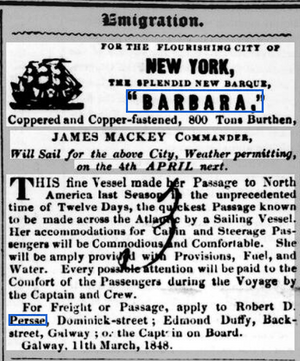
Here are a few notes and sources in case anyone is interested.
I was able to find the builder of the Barbara (Alexander Lyle of Halifax in 1846), her owner (Robet Dudley Persse, Esq. of Galway), and her Captain (James MacKay of Arbroath, Scotland). She made 4 voyages with emigrants to the United States between 1846 and 1850 as well as numerous others, primarily to Liverpool and St. Petersburg in Russia—trading primarily in goods such as flour, Indian meal, wheat, butter, hams, ashes, bacon, staves and guano.
Her owner, R. D. Persse, died in 1850 and all records for the Barbara disappear after that. It is unlikely she sank (or there would have been newspaper articles) or sold at public auction (no advertisements of a sale). She probably was sold privately, given a new name and a new Captain.
These are good sources for this kind of research:
Lloyd’s Register of Ships: https://archive.org/details/@lrfhec?&sort=-publicdate&page=2
Lloyd’s Documents related to ship plans and surveys: https://hec.lrfoundation.org.uk/archive-library/ships
British
 papers: https://www.britishnewspaperarchive.co.uk/
papers: https://www.britishnewspaperarchive.co.uk/

Last edited:
Just when I was about to give up looking for plans, I ran across this. The Emperor was built in 1849 and these plans were drawn in 1872, probably while she was undergoing repairs. My question is: although the Emperor is listed as a barque, are these plans for a barque? I'm confused by the size of the fore and mizzen mast in relation to the mainmast. 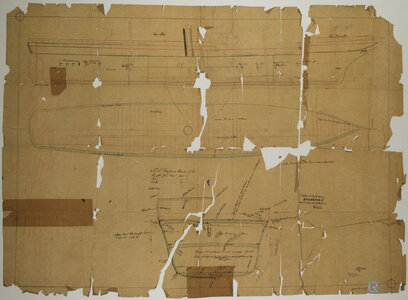
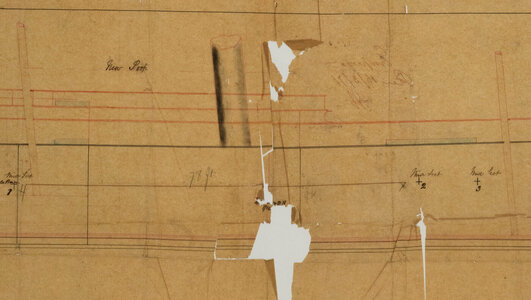


I think the main mast is not a mast, but a funnel
The hull form is showing a steamer
The hull form is showing a steamer
Great thread, very enjoyable! It's an entirely different side to the ship modeling hobby. Thanks for sharing.
Continuing the quest for plans for the Barbara, I ran across the following in Wikipedia when searching for "clipper barques". If clippers could be rigged as barques, then the question is really what hull structure to use in trying to reconstruct the Barbara.:
"A clipper is a sailing vessel designed for speed, a priority that takes precedence over cargo-carrying capacity or building or operating costs. It is not restricted to any one rig (while many were fully rigged ships, others were barques, brigs, or schooners), nor was the term restricted to any one hull type. Howard Chapelle lists three basic hull types for clippers. The first was characterized by the sharp deadrise and ends found in the Baltimore clipper. The second was a hull with a full midsection and modest deadrise, but sharp ends – this was a development of the hull form of transatlantic packets. The third was more experimental, with deadrise and sharpness being balanced against the need to carry a profitable quantity of cargo. A clipper carried a large sail area and a fast hull; by the standards of any other type of sailing ship, a clipper was greatly over-canvassed. The last defining feature of a clipper, in the view of maritime historian David MacGregor, was a captain who had the courage, skill, and determination to get the fastest speed possible out of her."
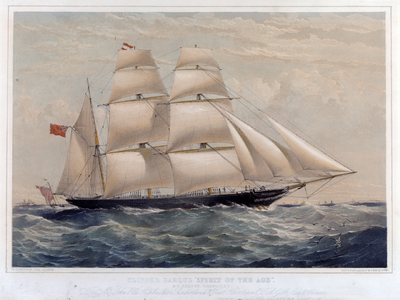
In Sailing Ships of the Maritimes (many ships out of Halifax), I read that the basic principles of the clipper were "the hollow bow and a high length-to-breadth ratio.... The round bow of the eighteenth century was giving way to the hollow bow and the sleek lines of the clipper." Since the Barbara was intended first as a packet ship, then "a hull with a full midsection and modest deadrise, but sharp ends" seems appropriate.
"A clipper is a sailing vessel designed for speed, a priority that takes precedence over cargo-carrying capacity or building or operating costs. It is not restricted to any one rig (while many were fully rigged ships, others were barques, brigs, or schooners), nor was the term restricted to any one hull type. Howard Chapelle lists three basic hull types for clippers. The first was characterized by the sharp deadrise and ends found in the Baltimore clipper. The second was a hull with a full midsection and modest deadrise, but sharp ends – this was a development of the hull form of transatlantic packets. The third was more experimental, with deadrise and sharpness being balanced against the need to carry a profitable quantity of cargo. A clipper carried a large sail area and a fast hull; by the standards of any other type of sailing ship, a clipper was greatly over-canvassed. The last defining feature of a clipper, in the view of maritime historian David MacGregor, was a captain who had the courage, skill, and determination to get the fastest speed possible out of her."

In Sailing Ships of the Maritimes (many ships out of Halifax), I read that the basic principles of the clipper were "the hollow bow and a high length-to-breadth ratio.... The round bow of the eighteenth century was giving way to the hollow bow and the sleek lines of the clipper." Since the Barbara was intended first as a packet ship, then "a hull with a full midsection and modest deadrise, but sharp ends" seems appropriate.
Last edited:
The advertisement in post #24 refers to the Barbara as a "clipper-built Packet Ship." This does not mean she was a clipper ship, which was a specialized type of vessel. She was a packet. "Clipper" and "clipper-built" are adjectives referring to a vessel that has finer lines and is less burdensome than others of its class. In the context of the advertisement the term is used to suggest to potential passengers and shippers that the ship is fast and sleek. Think of car ads that throw around descriptors like "luxury" and "sporty" and "high performance" but don't really mean anything.
No direct information about the searched ship , but maybe it is helpful when you take a look at the available paintings and also the contemporary drawings of Packet ships available at the NMM
 www.rmg.co.uk
www.rmg.co.uk
There is f.e. the Barracouta, which was build earlier but with a similar length
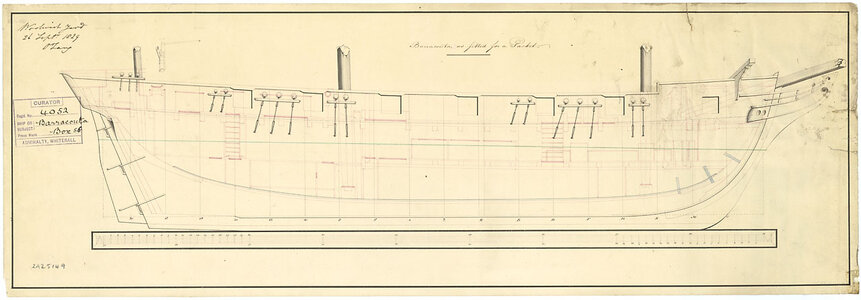
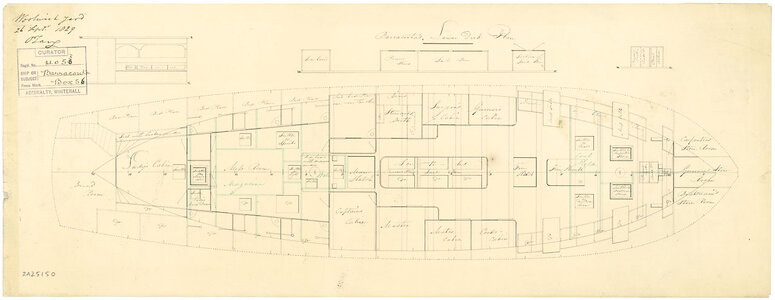
or the Alert from 1835

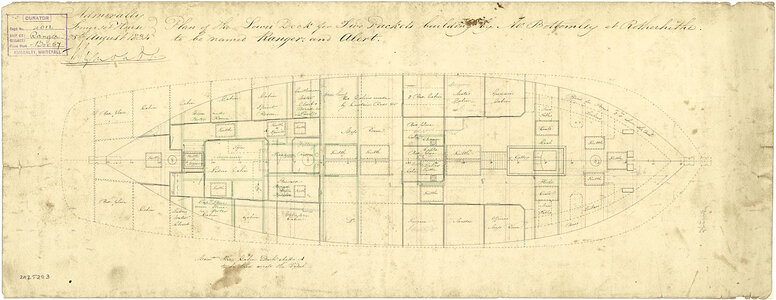
Collection Results | Royal Museums Greenwich
There is f.e. the Barracouta, which was build earlier but with a similar length


or the Alert from 1835


Thanks for the suggestions. It seems that there are not too many published plans for 19th century packet ships like the Barbara. I found the plan for a barque from 1857, the Alfred Neumann, that is quite detailed (this is the 1st of 2 pages of plans). I like it because it has a lower length to breadth ratio than the Alert and the Barracuda. There are replicas of two famine ships that are good resources...the Jeannie Johnston in Dublin and the Dunbrody in Wexford. Both, I think, are "clipper-like" in their dimensions. Unfortunately, there are no plans available for either of them.
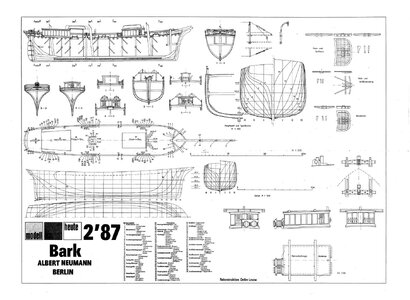
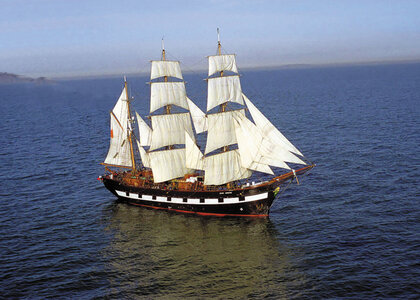
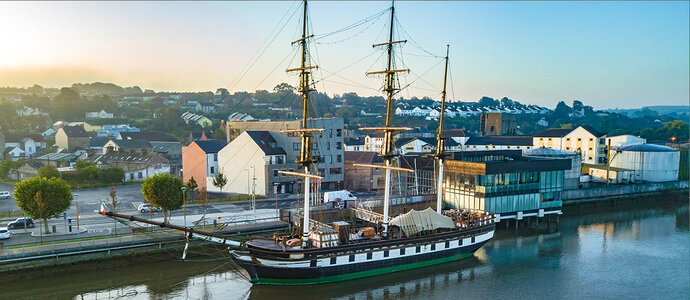



The Neumann, Johnston, and Dunbrody all look to be good examples of a packet. I think that you would find the lines of the latter two to be quite similar to those of the Neumann. And none of them is "clipper-like." Below are lines of the Fearless, a clipper ship built in East Boston in 1853. Nothing special about her but the lines were readily available. Compare these to the lines of the Neumann. The Fearless is sharper, the Neumann more boxy. On the sheer plans of the Fearless the buttock lines are further apart both fore and aft. The Fearless's half breadths are finer (more pointy). On the body plans the Fearless shows more dead rise (v-shape in her bottom) and the mold lines are spaced out whereas the Neumann has a flatter bottom and molds spaced out at the bow and stern but jammed closer together towards amidships. This all a long-winded way to translate 3-dimensional shapes into drawn lines and words. Bottom line is that, water will flow around the Fearless with less resistance than around the Neumann. Adjusting for other parameters (length being the most important), Fearless will be faster but Neumann will carry more cargo and/or people. Economics will decide the shape of a vessel.


Thanks for the post. Then, as now, speed was all the rage--especially for mail packets. The Barbara never carried mail (as far as I know), but she was quick to point out her speed as an enticement to any potential emigrants. This blurb comes from a Galway newspaper in 1847. My ancestors sailed on the Barbara in May 1848, and so maybe someone read them this blurb when they were trying to decide which ship to book passage on.
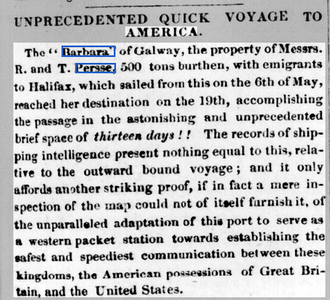

Hallo @DMDayIf I know that a bark built in Halifax in 1845 had a tonnage of 459 tons, is there any way to estimate the approximate length of that ship without knowing anything about its breadth or depth?
we wish you all the BEST and a HAPPY BIRTHDAY




